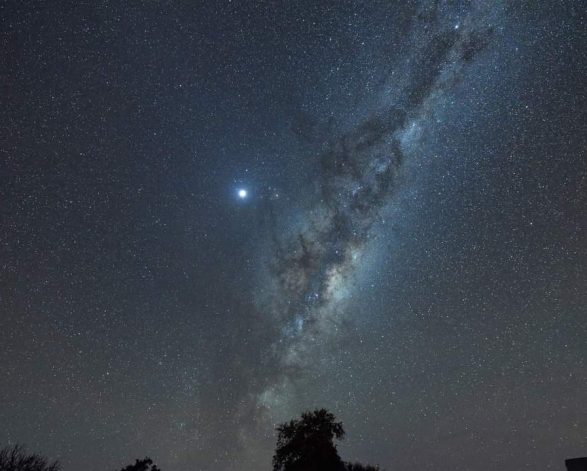For over 50,000 years, Aboriginal Australians have had a deep connection to the stars and planets, and their movement across the sky. This connection can be found in oral traditions, art and ceremonies, and cultural practices. The practical use of this knowledge was applied to navigation, creating calendars, and the harvest of food sources.
Most Indigenous groups across Australia were hunter/gatherers who moved across their countries to take advantage of seasonal food sources. They practiced careful land management techniques, such as fire stick farming, to increase the food yield on the land. These practices were guided by the seasons, and the change in seasons was marked by changes in the night sky. This understanding of the sky included eclipses, the motion of the Sun and Moon and the Moon’s link to tides, and the ability to predict the rising and setting places of celestial bodies.
Celestial objects also form an important part of the Dreaming, explaining the creation of the earth, sky and people, and the astral beings that influence life on earth. The spirit world was in the stars, and after death the spirit would return to the sky country. In some parts of Australia, oral traditions of the sky are complemented by rock art, stone placement and carvings that help to illustrate and mark celestial events.
While each group had stories and practices unique to their needs, several star stories are common across much of Australia, one of which is the Dark Emu that can be found in the dark patches and streaks between the stars of the Milky Way. Throughout the year, the position of the Dark Emu signals different food sources and tasks, which vary between groups across the country according to local needs.
The Ku-ring-gai people of Northern Sydney used the Dark Emu to predict when to gather eggs from the Emu nests, and when to hunt the birds for food. A carved Emu in the rocks of Ku-ring-gai Chase National Park lines up with the Dark Emu in the sky during the nesting season, signalling the time to gather eggs.
The first British settlers in Sydney Cove did not record much of the celestial knowledge of the Eora people, apart from their names for the Sun, Moon and stars, and many stories have been lost through the impacts of colonisation. A Dharug story that has survived is that of Kurrobori, the Spirit Woman.
A very long time ago, many thousands upon thousands of years ago, This Land was covered by the sea. Nothing grew here as we know it today, nothing lived here as we know it today. Only the Spirits of the sea inhabited the sea which covered This Land.
Kurrobori, the Spirit Woman, who comes from beyond the Rising Sun, from the Spirit Land which exists in the Morning Star, was passing by in her travels across the sky, and saw the water and the sea spirits.
Kurrobori stopped in her travels and caused This Land to rise up and the water to flow from the land. The sea spirits became very much afraid, and in their fear they left the river and valleys as their tracks, and pushed up the mountains as they fled to the retreating sea.
Kurrobori saw This Land and was pleased. She caused plants to grow to give her food, and caused trees to grow to give her shelter in which to rest, and caused the flowers to bloom on the plants and the trees to make her glad with what she had created. Kurrobori was happy, she had made This Land beautiful.
The story of Kurrobori told through traditional and contemporary dance features in the exhibition Enquiring Minds: exploration and discovery in colonial New South Wales, now on at Old Government House.
Although Aboriginal people have had these connections to the night sky through many thousands of years, it is only recently that western researchers have come to understand the deep traditional knowledge of the night sky in Indigenous culture. There is now much important work being done with the traditional owners of these stories to record them for future generations.
You can learn more about astronomy in our exhibition Enquiring Minds, featuring the first chart of stars in the southern hemisphere and some of the instruments used to compile it in the observatory next to Old Government House by Governor Brisbane 200 years ago.
I acknowledge and pay my respects to Aboriginal elders, past, present and future, and thank the traditional owners of these stories for sharing their knowledge.
Photo credit: Robyn Wong

 Twitter
Twitter Facebook
Facebook Linkedin
Linkedin Email
Email